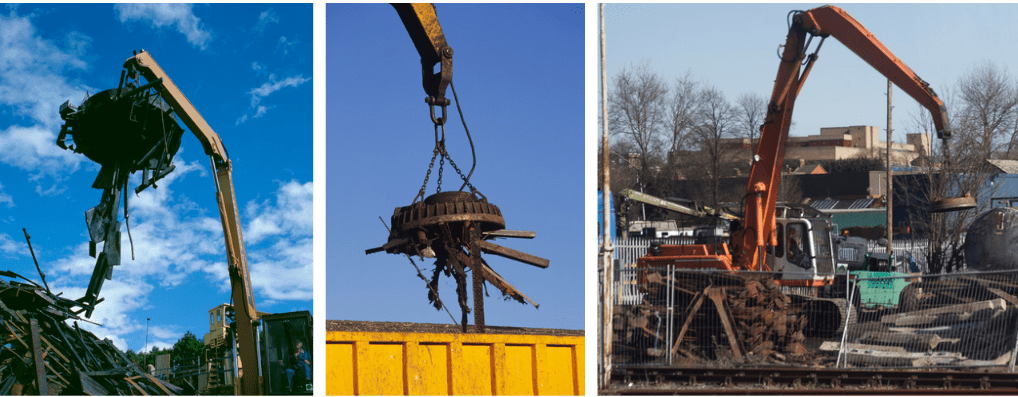Before we discuss about magnetic crane let us know a little bit about Crane. Crane is a heavy mechanical material handling equipment used in construction and various industrial applications. Crane is typically consisting of a tall vertical tower with a horizontal boom that can be extended.
Basically, Canes are used to lift and move heavy objects or heavy materials, Such as steel beams, concrete blocks, and heavy machinery from one location to another desired location. crane can lift and move objects vertically or horizontally. There are different types of cranes available like overhead cranes, tower cranes, truck-mounted cranes magnetic cranes, etc.

Table of Contents
What is a magnetic crane?
A magnetic crane is commonly known as an electromagnetic crane or magnet crane. Magnetic cranes are used in various industries to lift and transport heavy ferrous materials such as still iron and other magnetic materials. Actually, electromagnetic cranes utilize a powerful Electromagnet to create a strong magnetic field, which attracts and holds the materials securely during lifting and transporting the heavy materials.
In the realm of modern engineering marvels, magnetic cranes have emerged as a force to be reckoned with. These ingenious machines have transformed the landscape of material handling, offering efficiency, precision, and versatility like never before. In this article, we will discuss magnetic cranes and explore their technology, applications, advantages, and more.
Magnetic cranes, often referred to as electromagnetic cranes, are sophisticated pieces of machinery designed to lift and transport heavy loads with utmost precision. Unlike conventional cranes that rely on hooks, chains, or slings, magnetic cranes employ powerful electromagnets to securely grip ferrous materials, making them an indispensable asset in various industries.
How Do Magnetic Cranes Work?
These cranes function on a simple yet ingenious principle – the power of electromagnetism. By passing an electric current through a coil of wire, a magnetic field is generated. When this coil is energized, it attracts ferrous materials, such as steel or iron, providing a firm and reliable grip on the load.
Types of Magnetic Cranes:
Magnetic cranes come in various configurations to cater to specific needs. Some common types include overhead magnetic cranes, mobile magnetic cranes, and magnetic forklift attachments. Each type offers unique advantages and is tailored to particular applications.
Applications Across Industries:
The versatility of magnetic cranes finds application in a multitude of industries. From metalworking and recycling plants to shipyards and construction sites, these cranes are adept at handling diverse loads, ranging from steel beams to scrap metal.
Advantages of Magnetic Cranes:
Magnetic cranes boast numerous advantages, including:
- Precision: They offer pinpoint control during material handling.
- Efficiency: Quick and secure load attachment/detachment.
- Safety: Reduced risk of accidents and injuries.
- Cost-effectiveness: Enhanced productivity and reduced labor costs.
- Space-saving: Compact design for optimal space utilization.
Challenges and Safety Considerations:
While magnetic cranes are efficient, they also pose certain challenges. Safety is paramount, and precautions must be taken to avoid accidents due to unintended load release or malfunctioning electromagnets. Adequate training and adherence to safety protocols are essential.
Maintenance and Lifespan:
Regular maintenance is crucial to ensure the longevity of magnetic cranes. Periodic checks on electromagnets, wiring, and control systems help prevent downtime and costly repairs.
Future Innovations in Magnetic Cranes:
The field of magnetic crane technology is continually evolving. Innovations such as smarter control systems, enhanced lifting capacities, and remote operation are poised to make magnetic cranes even more efficient and user-friendly.
Environmental Impact:
Compared to traditional cranes powered by fossil fuels, magnetic cranes are environmentally friendly. Their electric operation reduces emissions and contributes to a greener future.
Case Studies: Real-World Applications of magnetic crane:
Explore real-world examples of how magnetic cranes have revolutionized industries, from automating scrap metal sorting to streamlining the assembly of massive structures.
Choosing the Right Magnetic Crane:
Selecting the appropriate magnetic crane for your specific needs involves considering factors like load capacity, workspace, and operational requirements. Consultation with experts is often recommended.
Cost Analysis: Magnetic Cranes vs. Traditional Methods:
A cost-benefit analysis reveals that while the initial investment in magnetic cranes may be higher, the long-term savings in labor and increased efficiency make them a wise choice for many businesses.
Safety Standards and Regulations:
Learn about the safety standards and regulations governing the use of magnetic cranes to ensure compliance and the well-being of your workforce.
Training and Certification:
Proper training and certification programs are available to equip operators with the skills and knowledge required to operate magnetic cranes safely and efficiently.
Conclusion: The Magnetic Crane Revolution:
In conclusion, magnetic cranes have redefined the world of material handling. Their precision, efficiency, and versatility make them indispensable in various industries. Embracing this technology can lead to safer, more efficient operations and a sustainable future.
FAQs on magnetic cranes?
Are magnetic cranes safe for use in hazardous environments?
Magnetic cranes can be used in hazardous environments, but safety protocols and precautions must be strictly followed to minimize risks.
What is the maximum weight that a magnetic crane can lift?
The lifting capacity of a magnetic crane varies depending on its type and specifications. Some models can lift several tons.
Do magnetic cranes require a lot of electricity to operate?
Magnetic cranes are energy-efficient, and their electricity consumption is relatively low compared to their lifting capacity.
Can magnetic cranes be used for delicate or fragile materials?
Magnetic cranes are best suited for ferrous materials. Delicate or fragile materials may require alternative handling methods.
How often should magnetic cranes undergo maintenance?
Regular maintenance checks should be conducted as per the manufacturer’s recommendations, but typically, they are done on a quarterly or semi-annual basis.
